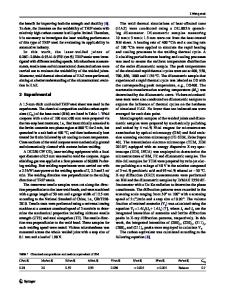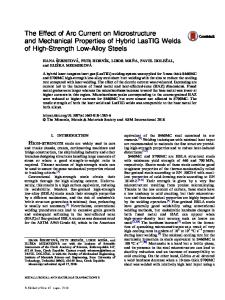Effect of Welding Current and Time on the Microstructure, Mechanical Characterizations, and Fracture Studies of Resistan
- PDF / 6,869,135 Bytes
- 20 Pages / 593.972 x 792 pts Page_size
- 30 Downloads / 320 Views
DUCTION
DIFFERENT welding methods have been developed for joining stainless steels; however, resistance spot welding (RSW) is the promising method for welding of thin sheets of these steels.[1–7] In the RSW method, overlapping sheets are placed between two electrodes and heat is obtained by passing a large electrical current for a short period of time.[8] Then, electrical resistance at the interface of metals causes a localized heating for joining of samples, and finally, the resistance spotwelded region will be produced by the combination of heat, pressure, and time of process.[9] Today, stainless steels, especially the low-carbon grades, are widely used due to their low chromium carbide in the heat-affected zone (HAZ). Stainless steel grade 316L, which consists of austenite and ferrite phases in the microstructure, is one of the important types of austenitic stainless steels. This grade is widely used in various industrial applications due to its high DANIAL KIANERSI and JAVAD MOHAMMADI, Masters of Science, are with the Department of Materials Engineering, Science and Research Branch, Islamic Azad University, Tehran, Iran AMIR MOSTAFAEI, Master of Science, is with the Young Researchers and Elites Club, Tehran North Branch, Islamic Azad University, Tehran, Iran. Contact e-mail: [email protected]; a_mostafaei@sut. ac.ir Manuscript submitted February 2, 2014. METALLURGICAL AND MATERIALS TRANSACTIONS A
corrosion resistance, decorative appearance, and excellent weldability.[10,11] Moreover, low carbon content decreases the formation of carbides in the grain boundaries that may appear within welding.[12] RSW of austenitic stainless steel sheets (316L) is frequently applied to transportation vessels, home and office items, kitchen furniture and utensils, building applications, and so forth. Nevertheless, one major disadvantage of the austenitic stainless steel is the HAZ, which is often sensitized by Cr-rich carbide intergranular precipitation during the welding process and leads to the reduction of corrosion resistance in the welded joint.[13] Two methods were recommended to solve this problem: first, the use of austenitic low carbon steel such as 316L, and, second, the rapid welding process of RSW, which can decrease the formation of these undesired carbides.[14,15] Fukumoto et al. reported that hot cracking is another problem that occurs in the welded region.[16] Based on their investigations, a small amount of delta ferrite in the microstructure of the welded nugget can inhibit the hot cracking problem and may decrease sensitization in the HAZ region under any circumstances.[16] In general, there are three issues for controlling the quality of resistance spot welds, as follows.[2,8,17] (1) The weld nugget diameter, which can be measured from the cross-sectional images taken from welded samples.
(2) The mechanical properties of the weld; the tensileshear test is the conventional method for evaluating mechanical behaviors of spot welds in static condition. Various parameters can be extracted from load–displacement
Data Loading...











